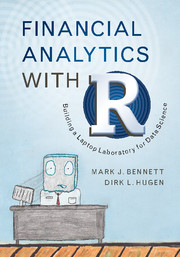Book contents
- Frontmatter
- Dedication
- Contents
- Preface
- Acknowledgments
- 1 Analytical Thinking
- 2 The R Language for Statistical Computing
- 3 Financial Statistics
- 4 Financial Securities
- 5 Dataset Analytics and Risk Measurement
- 6 Time Series Analysis
- 7 The Sharpe Ratio
- 8 Markowitz Mean-Variance Optimization
- 9 Cluster Analysis
- 10 Gauging the Market Sentiment
- 11 Simulating Trading Strategies
- 12 Data Exploration Using Fundamentals
- 13 Prediction Using Fundamentals
- 14 Binomial Model for Options
- 15 Black–Scholes Model and Option-Implied Volatility
- Appendix Probability Distributions and Statistical Analysis
- References
- Index
3 - Financial Statistics
Published online by Cambridge University Press: 20 October 2016
- Frontmatter
- Dedication
- Contents
- Preface
- Acknowledgments
- 1 Analytical Thinking
- 2 The R Language for Statistical Computing
- 3 Financial Statistics
- 4 Financial Securities
- 5 Dataset Analytics and Risk Measurement
- 6 Time Series Analysis
- 7 The Sharpe Ratio
- 8 Markowitz Mean-Variance Optimization
- 9 Cluster Analysis
- 10 Gauging the Market Sentiment
- 11 Simulating Trading Strategies
- 12 Data Exploration Using Fundamentals
- 13 Prediction Using Fundamentals
- 14 Binomial Model for Options
- 15 Black–Scholes Model and Option-Implied Volatility
- Appendix Probability Distributions and Statistical Analysis
- References
- Index
Summary
Statistics is a mathematical science which is concerned with collecting and organizing data and conducting experiments involving random variables which represent the data. These random variables can represent natural or simulated events. The amazing attribute of statistics is its ability to explain the organization of the data we observe. In this chapter we will cover some basic formulas that will lay a foundation for the subsequent analytics framework.
A discussion of statistics is necessary for any treatment of financial analytics. In order to discuss investments in financial instruments from a quantitative perspective, a certain amount of preliminary background is needed. This will provide a higher level of accuracy. We will not be able to do our job well without it. This background will be conveniently stated in terms of formulas, beginning here and continuing throughout the book. Formulas provide crisp specifications for the computer instructions in R.
We begin with probability with discrete outcomes. After completing the first three sections, the reader is invited to visit the Appendix for a review of the many potential probability distributions and statistical analysis concepts that are used in analytics.
Probability
In probability we are concerned with the likelihood of events. An event A is defined such that ∅ ⊆ A ⊆ S, where ∅ is defined as the null space or empty set and S is defined as the sample space or set of all possible outcomes. We also set that the probability of event A occurring as 0 ≤ P(A) ≤ 1, where the probability of the null space is P(∅) = 0 and the probability of the sample space is P(S) = 1. We define the complement Ac as the set satisfying 1) A ∪ Ac = S and 2) A ∩ Ac = ∅. While they might seem superfluous, these two conditions simply make mathematically rigorous the requirement that (1) an event must either happen or not happen, and (2) an event may not both happen and not happen.
- Type
- Chapter
- Information
- Financial Analytics with RBuilding a Laptop Laboratory for Data Science, pp. 23 - 43Publisher: Cambridge University PressPrint publication year: 2016



